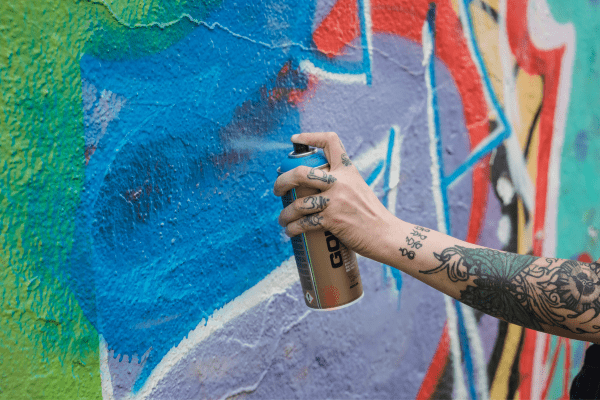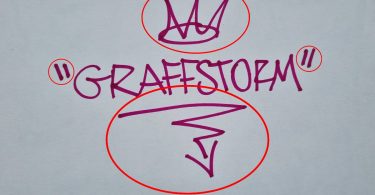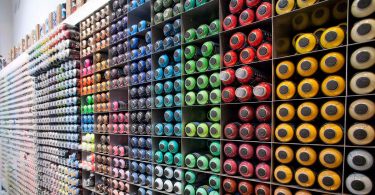Everyone remembers picking up a spray can for the first time and trying to draw something with it.
You’re instantly hit with the realisation that spray painting is much harder than it looks. Which makes you wonder “how the f**k do these guys do it?”.
Although the best answer I have is practice, practice, practice – there are some tips to make learning can control much easier.
So whether you’re a graffiti or street artist, learning canvas art or simply spray painting for fun – here are 12 tips for improving can control and painting like a pro.
Note: Mastering can control can take years of hard work and practice. It certainly isn’t quick or easy, so be prepared to put in the time needed to see results.
Contents
- 1. Choose a professional spray paint brand
- 2. Start with a low pressure spray paint
- 3. Practice with a skinny cap
- 4. Maintain a firm grip on the can
- 5. Get familiar with finger pressure
- 6. Control your distance from the wall
- 7. Move your whole body, not just your arm
- 8. Practice with simple shapes
- 9. Focus on outlines, forget fill-ins (for now)
- 10. Paint fast for cleaner lines
- 11. Commit to your lines
- 12. Don’t worry about fixing mistakes
1. Choose a professional spray paint brand
There are hundreds of different spray paints out there, but not all of them are designed for art.
For example, spray paints for cars or furniture paint have different formulas and valve pressures compared to professional spray paint for graffiti.
So before you begin, make sure you’re using spray paint specifically designed for graffiti and street art. Some of the most popular brands include Montana, MTN, Molotow, Loop and Dope (to name a few).
You may find that brands are different depending on where you live. As long as you’re using spray paint designed for art, it will be the best place to start for improving can control.
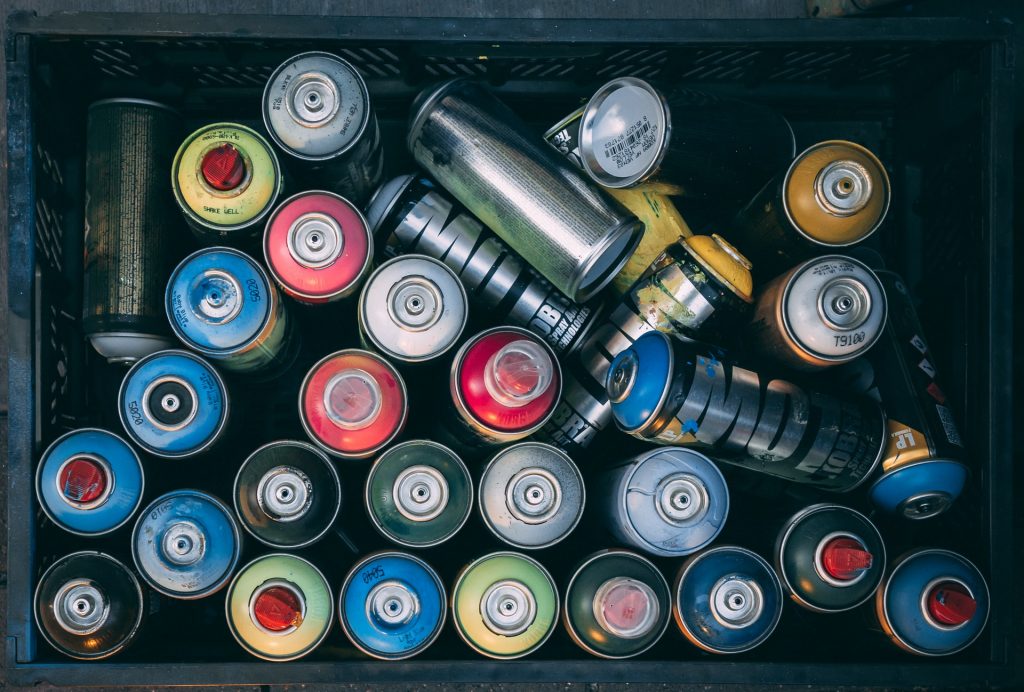
2. Start with a low pressure spray paint
Professional spray art tools will almost always specify whether the can is high pressure, medium pressure or low pressure. If you’re learning can control, it’s best to use a low pressure spray paint.
Spray paint pressure determines how fast spray paint leaves the can when it’s being used. High pressure cans mean that paint comes out much faster, so it can be difficult for beginners to control.
High pressure spray paint is better for covering large areas quickly instead of painting fine or detailed pieces.
Starting instead with a low pressure paint when learning can control is a much better option. You’ll have more control over the can which makes it much for forgiving for beginners.
There’s also less chance of drips too, which can be frustrating for new aerosol artists.
If you’re learning can control, the best low pressure paint brands to start with that are commonly found include Montana Gold, MTN 94, Molotow Premium and Kobra Low.
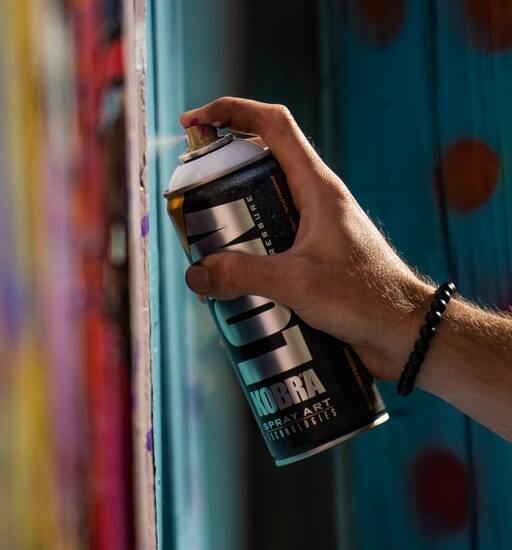
3. Practice with a skinny cap
Just like spray paint brands, there are loads of different spray paint caps designed for artists. Different caps have different uses – from making skinny lines, fat lines and also special uses like calligraphy.
When practising can control, it’s best to use a skinny cap. These are the best cap for line work and adding detail to your pieces, which are the most important elements to perfect for graffiti and street art.
Using a wider cap like a fat or super fat cap as a beginner will make learning can control much harder. You’ll get more drips and overspray due to the higher output. Plus, fat caps drain spray paint much quicker, so you’ll be spending more too.
Most low pressure spray paints come stocked with skinny caps already, like Montana Gold and MTN 94, for example. If you need extra caps to learn can control with, we recommend the Banana Universal Cap for beginners.
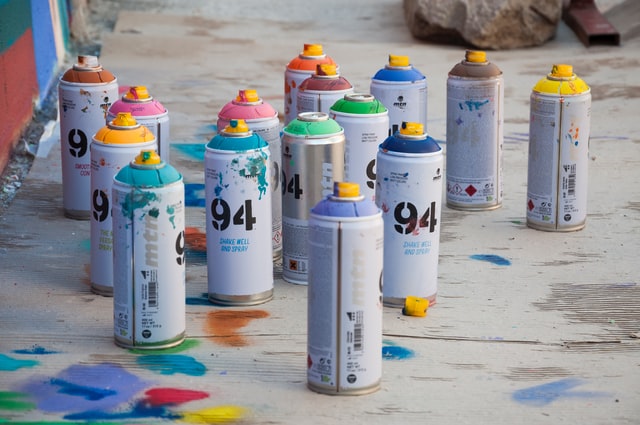
4. Maintain a firm grip on the can
This can control tip might sound obvious, but as a beginner, it can be easy to start spray painting with a loose grip and get into a bad habit early on.
Just like you wouldn’t hold a pen with a loose grip, maintain a firm grip on the spray can when painting.
This will do so much to improve your can control. With a firm grip, you have more control when it comes to producing clean lines and small details.
Plus, a firm grip is fundamental for some upcoming tips like finger pressure and controlling your distance from walls or surfaces.
5. Get familiar with finger pressure
Being able to control how much paint is released when you press down on the cap is the difference between a good graffiti artist and a great one.
Practice pressing down on the cap with different pressures. Try pressing down hard vs pressing softly to see the difference in how much paint is released. You’ll start to become more familiar with the different effects that are produced.
For maximum control press down softly on the back of the cap. This will release the paint slowly, allowing for super skinny lines and intricate details to be achieved.
6. Control your distance from the wall
The further away the spray can is from the surface you’re painting, the wider the line will come out. The closer the can is, the thinner the line will be.
Being able to consistently control your distance to achieve your desired effect is important.
This is a difficult one to offer tips on as (like all of can control) it’s learned through practice. Maintaining a firm grip on the can is a good start though, as you’ll have more control maintaining the right distance from the wall.
7. Move your whole body, not just your arm
A very common mistake new graffiti writers make when spray painting is only moving their wrist or arm when drawing lines.
It’s so important to spray paint with your whole body and not just your arm – especially for long lines. You’ll have far more control over the spray can and be able to produce cleaner lines way more consistently.
For example, moving your entire body makes it much easier to keep the can parallel to the wall and maintain your distance from the wall.
Only moving with your arm makes can control much harder and can result in poor linework, such as having to stop and start to achieve long lines which can look scrappy.
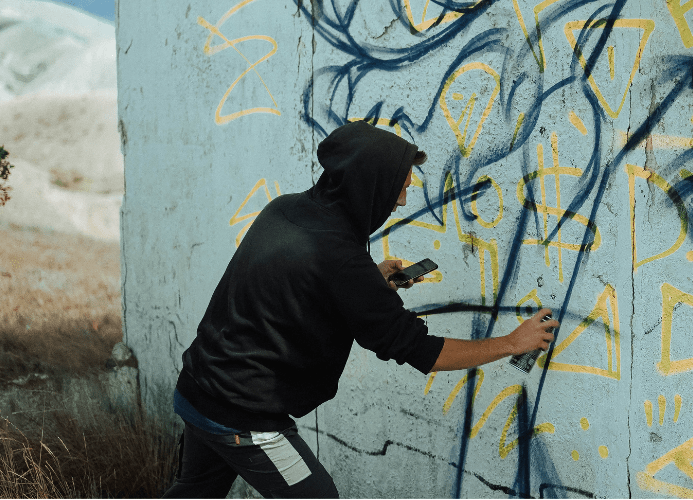
8. Practice with simple shapes
One of the best ways to get started with learning how to spray paint is by practising simple shapes.
For example, try painting circles, squares, rectangles and stars in different sizes using a skinny cap. Don’t worry about filling them in for now, these shapes are just to get a better feel of how can control and line work go hand-in-hand.
Drawing circles in particular is a great shape for can control. Bigger circles, for example, will force you to move your entire body which is essential for getting better at graffiti and street art.
Plus, it can be tricky to keep the can parallel to the wall when doing curved lines, so circles are great practice.
9. Focus on outlines, forget fill-ins (for now)
If you’re just focused on improving can control, don’t worry about filling your shapes or letters in until you’ve improved.
Although filling shapes and letters in is an important part of graffiti and street art, it’s not great for improving can control. Plus, filling in large areas will drain your cans quickly as you’ll need a fat cap to be efficient. This can make learning much more expensive.
Instead, practice drawing outlines until you’re more confident with painting an entire piece.
10. Paint fast for cleaner lines
How fast you move the can is incredibly important when it comes to painting clean lines and improving can control techniques.
Most beginners when they first pick up a spray can (myself included) move the can far too slowly, which makes for shaky and uneven lines. Painting this way also increases the risk of paint dripping.
Try painting lines at different speeds and you quickly see the difference that moving the can fast makes. This becomes even more important when you move on to using high pressure cans, as the chance of paint dripping increases.
11. Commit to your lines
Much like drawing on paper, one of the biggest mistakes new aerosol artists make is not committing to the entire line they’re drawing. Instead, beginners stop and start which results in poor work.
Mastering can control is about knowing exactly where you need to go and committing to any lines you draw. Even if the entire line isn’t perfect, it will usually look much better than one that’s been started over and over again because it wasn’t done in one motion.
Like can control in general, committing to lines can take a long time to learn. It will develop as you become more and more confident with a spray can.

12. Don’t worry about fixing mistakes
Last but certainly not least, this tip is one that many beginner artists struggle with when trying to get better at graffiti and spray can art.
If you make a small or even a medium-sized mistake in your piece, most of the time it’s better to leave it as it is than try to fix it. Trying to fix small mistakes does more harm than good and can make the piece look unprofessional.
It’s often really obvious when someone has done a poor job of fixing a mistake. Trying to cut back your line or bringing in another colour to fix a mistake isn’t worth it most of the time – especially for beginners.
A clean line that slightly overlaps something it shouldn’t is much better than 4 poor lines that attempt to fix the problem.
As you become better with can control and spray painting in general, you’ll become better at picking your battles when fixing mistakes.
Learning can control techniques and want to level up your graffiti? Check out our top tips for finding your graffiti style.
